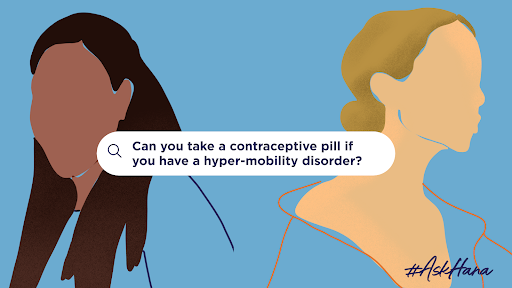Hypermobility disorders are a group of conditions that cause joints to be more flexible than normal, which is sometimes called being ‘double-jointed’. This can lead to joint pain, stiffness, injury, dislocation and other problems.
Whilst joint hypermobility is relatively common and affects around 1 in 30 people, you usually don’t need to worry if you don’t have symptoms. Around 10% of people with hypermobility do experience symptoms, including pain and frequent injuries. If you suspect you may have hypermobility, you should speak to your GP. Whilst there is no cure or specific treatment, there are ways you can manage your condition and the potential pain associated with it. You can find out more about hypermobility disorders and how to manage them here.
Hypermobility Disorder And Taking The Pill
Hormones can have an effect on hypermobility disorders. Hormones such as oestrogen and progesterone can influence the structure and function of collagen, which is a protein that gives strength and elasticity to connective tissue. Oestrogen tends to stabilise collagen, while progesterone tends to loosen it. This means that hormonal changes during the menstrual cycle, pregnancy, menopause or hormonal contraception can affect the symptoms of hypermobility disorders.
Best birth control for people with a hypermobility disorder
If you have a hypermobility disorder, you may be wondering if you can take the contraceptive pill safely and effectively. The answer is not a simple yes or no, as different pills may have different effects on your condition.
There are two main forms of hormonal oral contraception in the U.K. They are combined contraceptive pills, which contain synthetic versions of the naturally occurring hormones oestrogen and progesterone, and progestogen-only pills, which contain the synthetic hormone progestogen and does not contain oestrogen.
Progestogen-only methods of contraception may not be suitable for people with hypermobility disorders, as the natural hormone progesterone can lead to joint laxity and pain, as well as the risk of injury or dislocation. In general, patients with hypermobility disorders may want to avoid the injection and the implant, as these are progestogen-only methods. They might also want to avoid progestogen-only contraceptive pills. Everyone is different and more research needs to be done on the link between hormones and hypermobility, but it’s a good idea to speak to your doctor or pharmacist and let them know about any concerns you may have.
Contraceptive pills that contain oestrogen may have a protective effect on collagen and joint stability, as oestrogen can improve muscle mass and strength, and increase the collagen content of connective tissues. However, oestrogen also carries some risks for people with hypermobility disorders, especially if they have other factors that increase their risk of blood clots or cardiovascular problems. These factors include being overweight, having migraines with aura, smoking or having a family history of thrombosis or stroke. Oestrogen may also worsen some symptoms of EDS, such as bruising or bleeding.
Speak to your doctor or pharmacist about your contraceptive options and make sure they have all the information available to help you make an informed decision. If you are already on hormonal contraception and you get diagnosed with EDS or another hypermobility disorder, speak to your GP about whether you should change your contraception in light of this new information. Remember that you deserve to feel comfortable and confident in your contraception, and you can change it if it’s not working for you.
Best contraceptive methods for EDS/Hypermobility disorders
There are various contraceptive methods available, including hormonal and non hormonal options. These include barrier methods (such as condoms or diaphragms), natural family planning (such as tracking your fertile days and monitoring your temperature and cervical mucus), copper intrauterine devices (IUDs) or sterilisation (such as tubal ligation or vasectomy). Each method has its own advantages and disadvantages, and some may be more suitable for you than others depending on your condition.
For example, barrier methods are safe and effective if used correctly and consistently, but they may not be very convenient or comfortable for some people. Fertility tracking requires constant monitoring and may still not be effective as the exact point of ovulation varies from person to person and from month to month, so it’s not advisable if becoming pregnant is something that’s really important for you to avoid.
Copper IUDs are long-lasting and hormone-free devices that are very effective at preventing pregnancy and once it’s inserted they can be effective for 5-10 years, but some people may experience pain when getting them fitted and removed and may feel uncomfortable not having a daily reminder that they are taking contraception.
Sterilisation is a permanent method that involves blocking or cutting the tubes that carry eggs or sperm to prevent pregnancy, but it requires surgery and it is not reversible. Remember that everyone is different and the right contraceptive method for you may not be the same as it is for someone else. You may also need to try a few different methods before you find something that feels right.
—
Ultimately, the choice of contraception is yours to make based on your personal situation and preferences. Remember that no contraceptive method is 100% effective, and that only barrier methods can protect you from sexually transmitted infections (STIs). Speak to your doctor or pharmacist if you have any questions about which contraceptive method is right for you.
Hana® 75µg film-coated tablets contains desogestrel and is an oral contraception for women of child bearing age to prevent pregnancy. Always read the instructions on the package leaflet carefully.


